Is it possible to cover a gas pipe with siding: rules and subtleties of masking a gas pipeline
Are you planning to add siding to your home, but find that the gas pipe is too close to the wall? Natural gas is a dangerous substance, and it is not for nothing that all work related to it is strictly regulated. Agree, you don’t need any problems with the gas service or the threat of an explosion after finishing.
Every year, dozens of people die from explosions and fires of domestic gas, and hundreds more lose their homes. In most cases, the cause of the tragedy is an incorrectly performed re-equipment. If everything is done according to the instructions, the fresh facade will not only be beautiful, but also safe.
Representatives of the gas service do not care about the beauty of the facade of your house; their demands are justified only by safety. We will tell you about compromise options on how to cover a gas pipe with siding, in which the result will meet all standards and look aesthetically pleasing. At the same time, we’ll figure out what standards exist and what demands of gas workers are legitimate.
The content of the article:
When will a pipe interfere with siding?
Before figuring out how to solve a problem, it’s worth finding out whether it applies specifically to your situation. The gas pipeline can create problems when covering a house with siding only when it runs along the wall of the building.
In addition, if you are sheathing a house without insulation, with sheathing of minimal height or without it at all, the existing gap between the wall and the pipe may be quite sufficient for you, and you will not need to do anything with it.
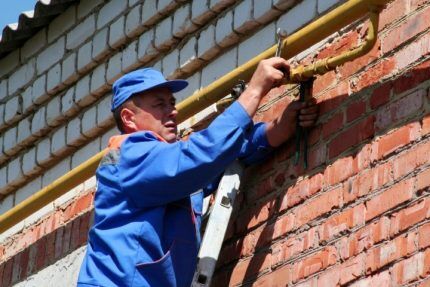
The pipe will become a hindrance if it is already located at a distance of no more than 6 - 7 cm from the wall, and also if there are already violations in its location at the moment. Another reason for replacing a pipe, and at the same time for its displacement, may be its wear and tear - for example, rusty spots that threaten a gas leak.
Legislative requirements for the gas pipeline
There are a number of regulations that gas workers can refer to in this matter. Among them: building codes and regulations 42-101-2003, 2.04.08-87, 31-02, 2.07.01-89, and, Safety rules in the gas industry, Rules for the design and safe operation of pressure vessels, Rules for the use of gas in the national economy and others.
According to these documents, gas pipelines are external and internal, those located inside buildings. The first are divided into above-ground (on supports or walls), above-ground (in embankments) and underground. In addition, gas pipelines vary in pressure, depending on their purpose and diameter.
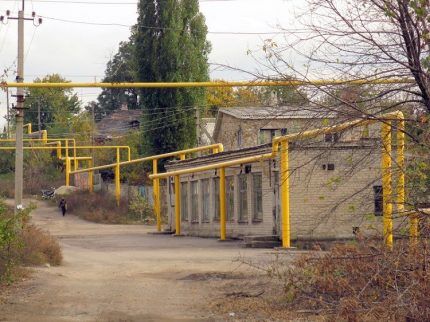
All work on all types of gas equipment, from laying the main line to connecting the stove in the house, must be carried out by qualified specialists who are certified and have permission to carry out such work.
Only specialists know and will be able to comply with all standards, requirements for all SNiP, as well as the rules of the Ministry of Emergency Situations and electricity supply services.
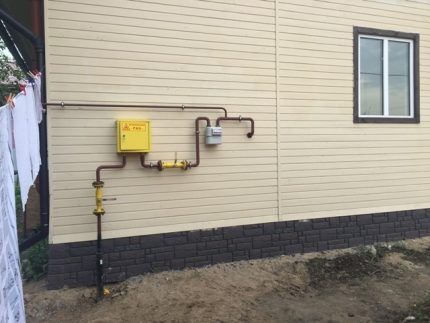
To find out whether your gas pipe is installed correctly now, whether the correct location will remain after covering with siding and where it can be moved, if necessary, we recommend that you familiarize yourself with the following requirements of the listed regulations:
- gas is supplied to residential buildings in an open way - so that at any time it is possible to assess the condition of the pipe, its prevention, maintenance and repair;
- the gas pipe can be fixed on support poles or attached to the wall of the building. Perhaps, in order to solve the problem of finishing and extensions once and for all, it is worth placing it on supports away from the building. The distance between such supports for each specific case is indicated in SNiP 2.04.12-86;
- a pipe laid along an external wall must be located at a height from the ground of at least 2.2 m;
- there must be at least 0.2 m from the gas pipeline to the roof;
- it is prohibited to lay pipes closer than 0.5 m from windows and doors, as well as install detachable connections under windows and balconies;
- the tap shutting off the gas supply should be located no closer than 50 cm horizontally from windows and doors;
- the gap from the wall surface to the pipe should be at least 6 cm;
- the pipe is fixed to the wall using hook-brackets or clamps with a rubber electrical insulating gasket;
- It is prohibited to fix the pipe to the fasteners by welding;
- It is prohibited to lay gas pipes along the wall medium and high pressure – it is better to bring them underground, with access to the surface immediately before entering the house;
- in an area where there are no pedestrian paths or highways, the gas pipeline can be located at a height of 35 cm from the ground. However, in practice it is rarely lowered below 2 m, because the pipe must run high along the wall, and the general distribution pipe is carried out on supports about 2 m high.
Pipes should only be painted with yellow paint that is resistant to temperature changes and moisture - for example, oil or alkyd enamel. Under the paint you should apply 2 layers of primer, and the paint itself should also be applied in 2 layers.
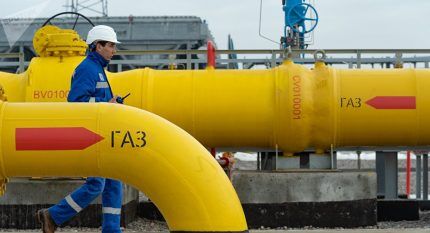
Thus, according to the regulations, the answer to the question “is it possible to cover gas pipes with siding?” will be negative.
Options for solving the problem
If, after finishing, the gas pipe attached to the outside of the house passes at a distance of less than 5 cm from the surface of the siding or even ends up under it, there are several options for solving the problem.
This depends on the specific location of the gas pipeline, as well as on how much money, effort and time the owner is willing to spend on resolving this issue. Let's consider the main options, their implementation methods, advantages and disadvantages.
Option number 1 - move the pipe on the brackets
This is perhaps the simplest way out, but it is not available in every situation.This method implies that the long pipe has some flexibility, which means that it can simply be moved away from the wall by lengthening the mounting brackets.
The ideal situation for this option is to cover smooth walls with siding, without lathing or insulation. In this case, a shift of only a few centimeters will be required - only by the thickness of the most convex part of the siding.
At best, a shift is possible by 5, maximum 10 cm, so if a layer of insulation is planned under the siding, this is unlikely to be enough. In addition, if the pipe is rigidly fixed, for example, on a support, or welded to main pipe near the corner of the house, this method may not work. There may also be difficulties in entry point into the house, because violence and strong bending are unacceptable.
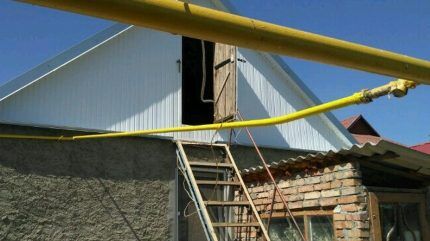
This option is practically free, you only need to buy new long brackets, and they are inexpensive. It is also possible that you will have to pay extra to the sheathing specialists for their installation and fixation of the pipe.
This method also does not require any time investment: if the pipe can be moved in this way in principle, then this can be done quickly, during the preparation of the surface for cladding.
Before you start decorating the walls, resolve the issue with the pipe. To increase safety, turn off the valve at the beginning of the pipe, if there is one. Try to remove it from the brackets - it can be firmly fixed to them by layers of paint.
Instead of brackets, the pipe can be fixed with hooks on which the pipe lies, or with clamps that wrap around it - in the second case, they should be unscrewed.It is better to take new fasteners in the form of clamps so that the pipe does not spring back to the wall in its natural position. Securely fix the brackets in the wall, and then the pipe in the clamps.
Option No. 2 - moving the pipe by gas workers
In terms of safety and reliability, this option is the most preferable. This method is perhaps the most expensive in terms of time, money, and nerves. But the result will be 100% legal and safe, the pipe will not interfere with the finishing, and in the future there will be no problems with safety and its maintenance.
This option for solving the problem is always possible; the only “contraindication” may be the urgency of the work, because it will not be possible to solve this issue in a day or two. In addition, you will need all the documentation for the house and land, from ownership to gasification plan – naturally, she should be fine too.
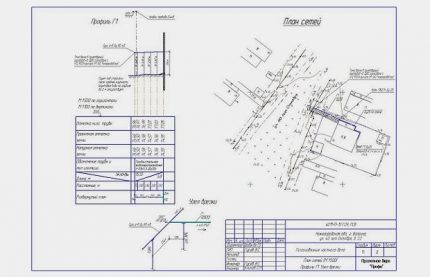
The advantages of this method are: reliability, legality, safety, and will not interfere with high-quality insulation. Among the disadvantages, it is worth noting the high cost and length of the process.
The specific cost amounts depend on the region and the company servicing the gas pipeline in the area. In addition to the work of gas workers and materials, you will have to pay for the preparation and execution of a project approved by the gas service. In addition to Gorgaz’s official prices, you can always negotiate directly with their own qualified craftsman, and this will probably be cheaper.
Provided that you have all the necessary documents for the house in order, the paperwork will take from 2 days to a week.After this, they will agree with you on the date of the gas technician’s visit, which depends on the availability of the specialists. A certified specialist from the city gas service may be available the next day or only a month later.
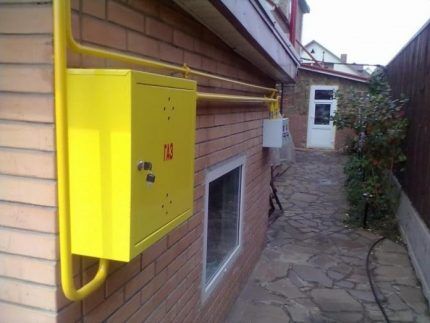
However, we recommend waiting for him, and not contacting third-party specialists, who often do not have permission to perform such work.
To speed up the process, we recommend doing the following:
- Collect a package of documents: confirmation of ownership of the plot and house; the current gasification plan, according to which the pipes are currently installed; perhaps a site plan with notes on all types of communications. Think about how you would like to position the new pipe.
- With the listed documents, contact Gorgaz or your local gas supplier and make a written application with the corresponding request, indicating your address. Typically, employees provide a standard form for such a case.
- Wait at the specified address for a gas service worker who will assess the situation live and confirm the possibility of the proposed transfer or offer his own option. The same employee or another specialist will draw up an estimate, calculating all the necessary materials and actions of the gas workers. The cost of work and the complexity of the procedure will increase significantly if it is necessary to draw up a new technical plan for the placement of gas equipment - for example, when, due to a change in the gas injection point, it is planned to move a gas boiler, water heater, stove or other appliances.
- Pay the receipt according to the estimate, after which a date will be set for the work to be completed.
- When the workers arrive, check that they have permission to service the gas pipeline. It must be confirmed no more than 1 year ago. Then all you have to do is watch the professionals at work. If necessary, they will shut off the gas supply in the main pipe, cut off the old branch with a grinder and weld its place. Then a hole will be made in the pipe in a new place, a new branch will be welded to it, a tap will be installed if necessary, and the pipe will be secured to the wall or on supports. At the entrance to the house, according to the work plan, the new pipe will either be welded to a piece of the old one, or lead inside, to the meter. Finally, the tightness of all welds and connections is checked. Do not let the craftsmen go until you re-read the report they drew up, which should list all the work performed on the gas pipeline.
- With the received report, contact the gas service again to make any changes to the technical documentation of the house and site.
The new pipe must be treated with 2 layers of metal primer, and 2 layers of moisture-resistant paint, always yellow, must be applied on top. Painting in other colors and masking is not allowed.
Option No. 3 - open channel in siding
If you don’t have time, money or desire to bother with gas workers and move the pipe, you can bypass it when covering it by constructing a channel from siding. However, this solution also has disadvantages: the work is quite labor-intensive, the appearance of the facade may suffer, and due to the lack of insulation, a cold bridge will remain under the pipe, along which the wall can freeze.
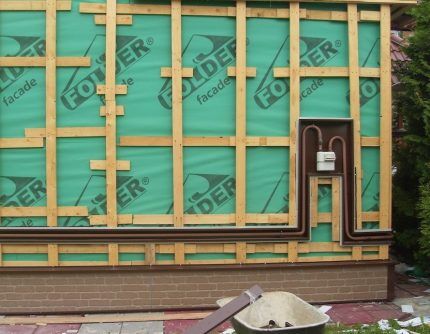
It is advisable to use this option if the pipe was initially laid correctly - no closer than 5 cm from the wall, and the siding specialist is ready to take on such a task.
Additional costs will include corner and j-shaped siding profiles - their length is 2 times longer than the pipe along the wall, additional profiles or beams for sheathing, as well as the services of a craftsman performing the work. The construction of such a channel is quite a troublesome task, so it will cost somewhat more than covering a flat wall.
Depending on the qualifications of the craftsman and the length of the area where the channel will be, as well as on the type of siding itself, the work can take several hours to a couple of days.
If it is time to paint a gas pipe, it is better to do this before the sheathing begins. It is necessary to provide for the arrangement of the channel at the very beginning of work, when arranging the sheathing for siding or under insulation, if there is one.
During this period, it is necessary to lay 2 horizontal beams or profiles along the pipe: one close to the wall, and the second flush with the main lattice under the siding. The distance to the pipe is calculated as the thickness of the siding plus 6 cm, and it is advisable to add a couple more centimeters of reserve.

If the main siding is too textured - for example, it imitates the logs of a log house - it is better to purchase smooth plastic for the channel to match the color of the facade. When sewing siding onto the sides of the channel and installing corner profiles, care should be taken not to damage the pipe with the tool.At the end of the work, there should be a distance of at least 6 cm from the pipe on all sides to the sheathing material.
The issue of aesthetics is one of the key ones when looking for a solution with a gas pipe and house cladding, so in order for such a structure to look more aesthetically pleasing and not spoil the appearance of the facade, there are several recommendations:
- It is better to choose a siding color that will match the yellow color of the pipe;
- make a gutter along the entire length of the wall, and if the pipe encircles the house, along the entire perimeter of the building;
- You can organize the lighting of the channel, turning it into an artistic idea. If the house is one-story and the pipe runs along the top of the wall, a gutter under the eaves will look impressive, which will additionally create darkness and emphasize the lighting;
- Sometimes it is proposed to turn such a channel into a box, covering it from the outside with a removable strip of siding with ventilation. But the gas workers themselves cannot answer unequivocally whether it is possible to cover gas pipes with siding in this way - it seems that there is access for maintenance along the entire length, but at the same time it is closed. Therefore, even after receiving the approval of one gas service employee, you can run into a fine when checked by another employee.
How exactly disguise a gas pipe beautiful and safe - the choice is yours!
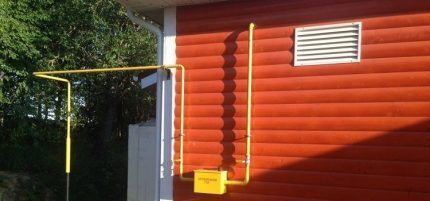
We remind you that painting the pipe any color other than yellow, as well as masking it with any finishing materials, is prohibited.
Sewing up a pipe - what are the dangers?
Some owners prefer to ignore all the rules and regulations and do what is most convenient: cover the gas pipe with siding.We will discuss the opportunities and threats of this option below.
As a rule, this is done by those homeowners whose gas is piped into the house from the rear side, invisible from the street, and inspectors from the gas service rarely come. However, we should not forget about the dangers of such a decision, because the rules were written not to issue fines, but to ensure the safety of your life and health.
Initially, no additional investments will be required - the pipe will simply be under the casing. However, if the inspectors see this, you will be disconnected from the gas supply until the situation is corrected, and you will have to pay not only for installing a gutter in the casing or moving the pipe, but also for a fine and reconnection.
Sewing the pipe tightly will take the same amount of time as it generally takes to cover a given wall with siding. If you subsequently have to redo everything according to standards, then time will be added to the installation time to disassemble the cladding of the upper half of the wall.
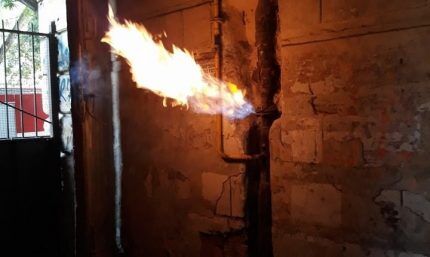
If such a situation arises on the instructions of the controller, your house will be cut off from gas supply for the entire time of re-equipment. In the case of a pipe transfer, this could be a month or more.
If you still decide on this option, take care, if not about following the rules, then at least about your own safety. To do this, do not completely seal the pipe with insulation; leave at least a small cavity along its entire length.
Make several ventilation holes in the siding at the level of the pipe, and install in one of the spaces between them gas analyzer – a sensor that can warn you about a leak in advance.
Conclusions and useful video on the topic
This is what the pipe looks like, sufficiently moved away from the wall on fasteners-clamps:
How to build a channel for gas pipes will be discussed in the following video:
The decision whether to hide the gas pipe under the siding remains only yours, but you also bear responsibility for such a decision and its consequences. Once again, weigh the pros and cons of each option specifically for your situation to choose the best path.
Have you already encountered such a problem? If yes, how did you solve it? Perhaps you know other options for getting out of a similar situation? Share your experience in the comments below - we are interested in your opinion.



